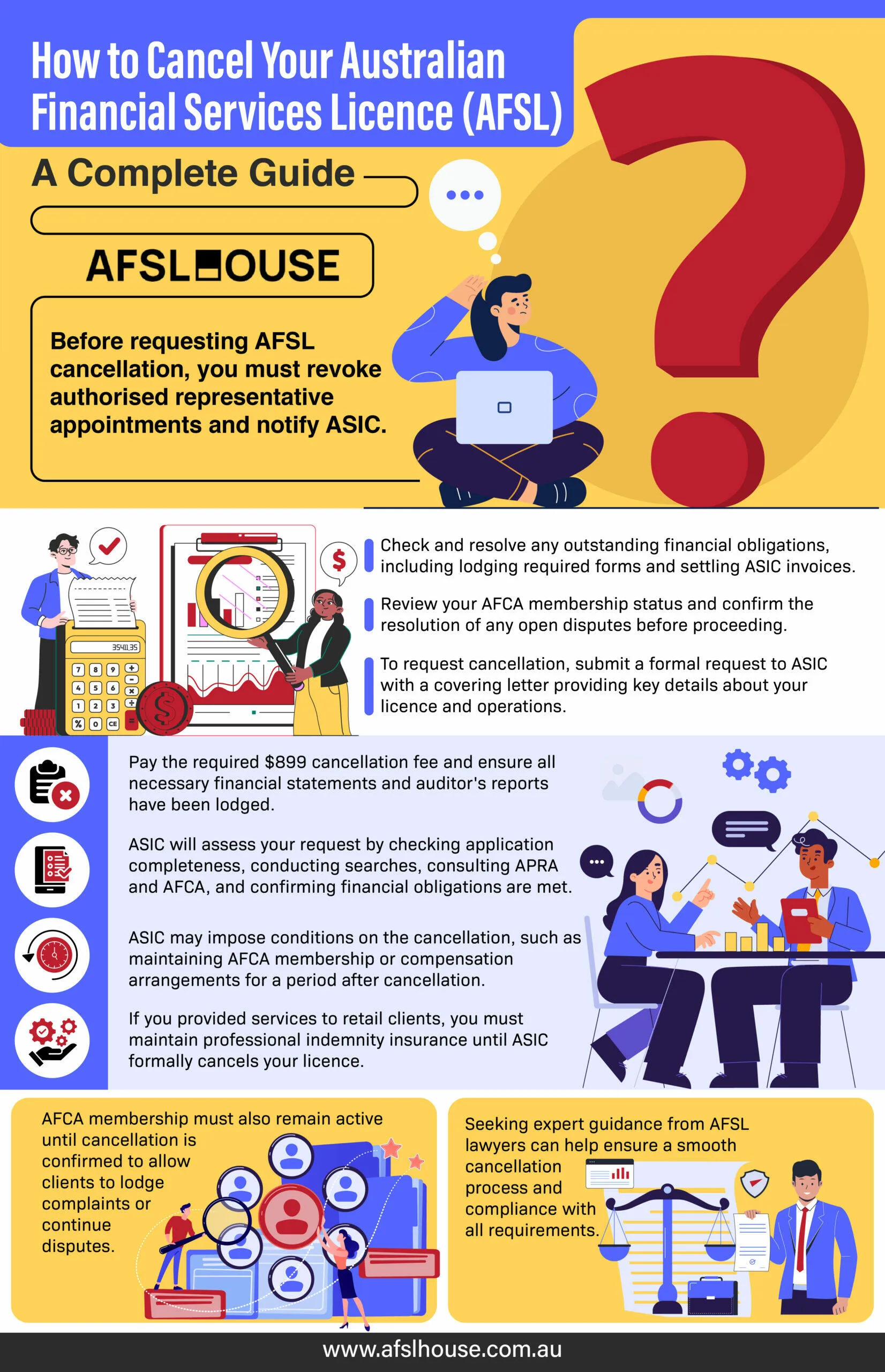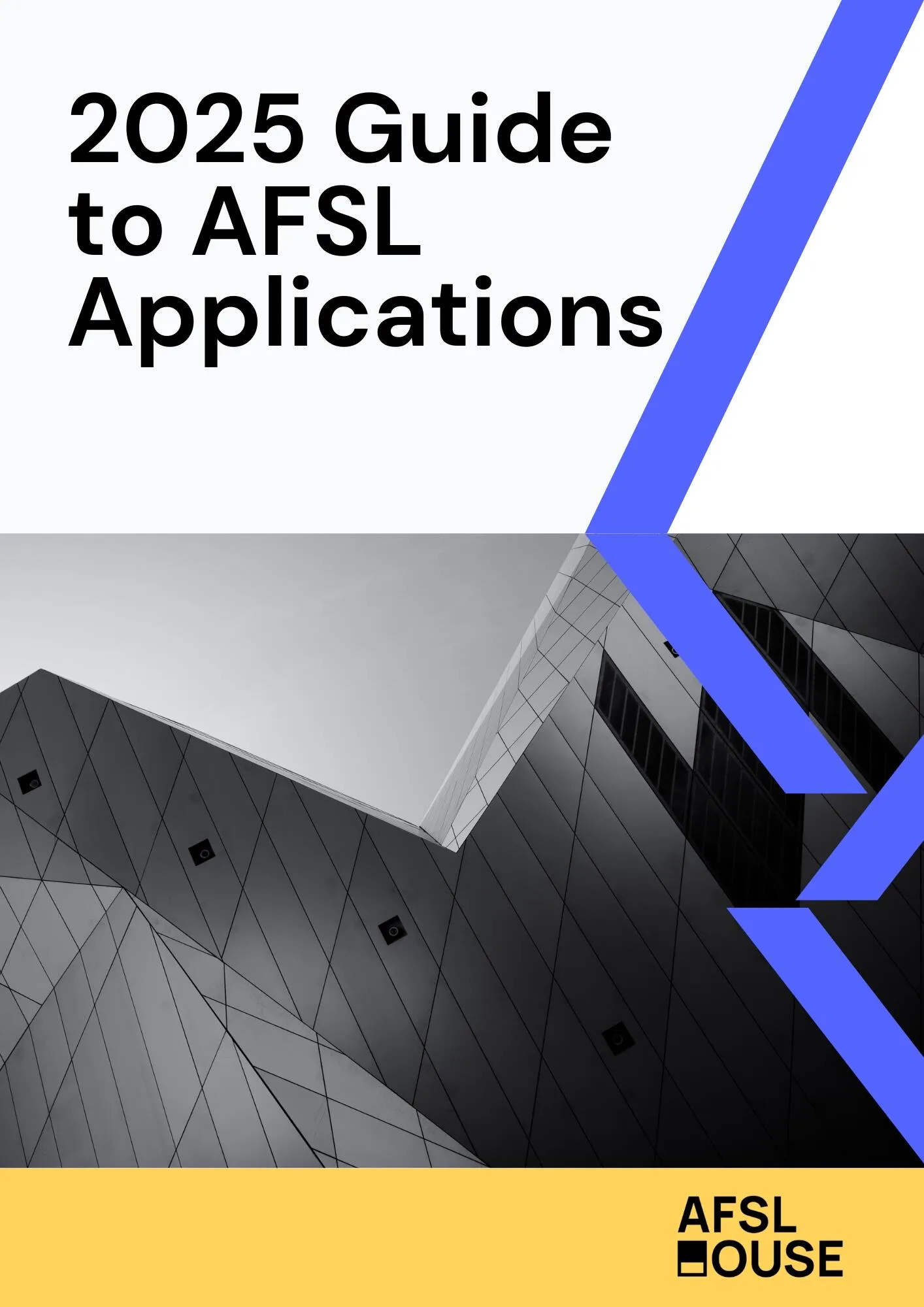Introduction
If you no longer need your Australian Financial Services licence (AFSL), you can apply to ASIC to cancel it. However, much like suspending an AFSL, cancelling an AFSL is not as simple as just handing it back. ASIC requires an explanation for the cancellation request and conducts multiple checks before your licence can be cancelled to ensure any open disputes or claims are resolved.
Before requesting cancellation, you must take several preparatory steps such as revoking authorised representative appointments, checking outstanding ASIC invoices and financial statements, and confirming the status of any complaints with the Australian Financial Complaints Authority (AFCA). This guide will walk you through the detailed process of requesting AFSL cancellation, the information you need to provide, and what to expect from ASIC’s assessment.

Steps Before Requesting AFSL Cancellation
Before requesting the cancellation of your AFSL, it is essential to complete several preparatory steps. These steps ensure the cancellation process proceeds smoothly and help you avoid potential complications. Below is a structured breakdown of the key actions you need to take.
1. Revoke Authorised Representative Appointments
The first step is to revoke any authorisations granted to representatives under your AFSL. This process involves:
- Notifying ASIC: You must notify ASIC of these revocations through ASIC Connect within 10 business days of the revocation.
- Informing Representatives: It is equally important to directly inform all authorised representatives about the revocation of their authorisation.
Completing this step ensures that no representatives remain authorised under your licence at the time of cancellation.
2. Check Outstanding Financial Obligations
Before proceeding with the cancellation, you must verify and address any outstanding financial obligations. This includes:
- Lodging Form FS70: Submit the Australian Financial Services Licensee Profit and Loss Statement and Balance Sheet (Form FS70) for any financial year ending before the licence cancellation.
- Submitting Form FS71: Provide the Auditor’s Report for AFS Licensee (Form FS71) for all relevant financial years.
- Settling ASIC Invoices: Confirm and settle any outstanding ASIC invoices by contacting the Customer Contact Centre to avoid delays in the cancellation process.
Ensuring all financial obligations are resolved is critical to avoid complications during the cancellation process.
3. Review AFCA Membership and Disputes
A thorough review of your AFCA membership and any existing disputes is required. Key actions include:
- Confirming Complaint Status: Verify the status of any existing complaints lodged with AFCA.
- Maintaining Membership: Ensure your AFCA membership remains active until the licence cancellation is officially confirmed.
- Understanding ASIC Inquiries: Be aware that ASIC will conduct independent inquiries with AFCA to confirm the resolution of any open disputes before approving your cancellation request.
Maintaining compliance with AFCA requirements ensures that there are no unresolved disputes that could delay the cancellation process.
Get Your Free Initial Consultation
Consult with one of our experienced AFSL Lawyers today.
The AFSL Cancellation Process
Once you have completed the necessary preparatory steps, including revoking authorised representative appointments, addressing financial obligations, and reviewing AFCA membership, you can proceed with the formal process of cancelling your AFSL. Below is a detailed guide to the key steps involved.
1. Preparing the Cancellation Request
To formally request the cancellation of your AFSL, you must submit a cancellation request to ASIC, accompanied by a covering letter. The covering letter should include:
- Your licence number and a clear request for cancellation.
- Confirmation that you have ceased or will cease providing financial services, along with the date of cessation.
- Reasons for ceasing operations and whether you will continue under an exemption.
- Disclosure of whether your business is under administration, regulated by APRA, or has related bodies corporate that are APRA-regulated.
- Your contact details, including postal address, email address, and telephone number.
The request and covering letter should be emailed to Licensing.AFSLproofs@asic.gov.au.
2. Required Documentation and Fees
ASIC requires specific documentation and payment of a fee to process your cancellation request. These include:
- Cancellation Fee: A fee of $899, which must be paid before ASIC will begin processing your request. Once your request is received, ASIC will issue an invoice for the fee.
- Outstanding Documentation: Ensure all required financial statements (Form FS70) and auditor’s reports (Form FS71) for relevant financial years have been lodged.
Submitting complete and accurate documentation is critical to avoid delays in the cancellation process.
3. ASIC’s Assessment Process
Once your request is submitted, ASIC will conduct a thorough review to determine whether your licence can be cancelled. This process includes:
- Verifying Application Completeness: ASIC will check that your application is complete, accurate, and properly authorised.
- Conducting Intelligence Searches: ASIC will perform searches and inquiries to identify any potential issues that could prevent cancellation.
- Consulting with APRA: If your business is APRA-regulated, ASIC will consult with APRA to confirm there are no outstanding matters.
- Checking with AFCA: For licensees providing services to retail clients, ASIC will contact AFCA to confirm the status of any open disputes.
- Confirming Financial Obligations: ASIC will ensure there are no outstanding financial statements, auditor’s reports, or unpaid invoices.
4. Potential Conditions on Cancellation
Based on its assessment, ASIC may impose conditions on the cancellation of your licence under Section 915H of the Corporations Act 2001 (Cth). These conditions may include:
- Maintaining AFCA membership for a specified period after cancellation to address any unresolved disputes.
- Maintaining adequate compensation arrangements, such as professional indemnity insurance, for up to 12 months post-cancellation.
Once ASIC has completed its review, they will prepare a letter and Notice of Cancellation, which will be sent to you for review. The final notice will also be published in the ASIC Gazette.
Speak with an AFSL Lawyer Today
Request a Consultation to Get Started.
Post-Submission Requirements
After submitting your AFSL cancellation request, there are ongoing obligations you must fulfil until ASIC formally cancels your licence. These requirements ensure that client protections remain in place throughout the cancellation process. Below is a structured overview of these obligations.
1. Maintaining Professional Indemnity (PI) Insurance
If you provide financial services to retail clients, you are required to maintain Professional Indemnity (PI) insurance until ASIC officially cancels your licence. This ensures that clients remain protected during the cancellation process. Key points to note include:
- Condition for Cancellation: Maintaining PI insurance is a mandatory condition for licence cancellation.
- ASIC-Imposed Conditions: ASIC may impose additional conditions requiring PI insurance coverage for a specified period after the licence is cancelled.
Ensuring your PI insurance remains active is critical to meeting ASIC’s requirements and protecting your clients during this transitional period.
2. AFCA Membership Obligations
For licensees who provided financial services to retail clients, maintaining AFCA membership is also required until the cancellation is confirmed. This allows clients to lodge new complaints or continue with existing disputes during the cancellation process. Key considerations include:
- Continued Membership: AFCA membership must remain active until ASIC formally cancels your licence.
- Post-Cancellation Conditions: ASIC may require you to maintain AFCA membership for a specific period after the licence is cancelled. For example, ASIC might impose a condition requiring continued membership for 12 months to address any unresolved disputes.
Ensuring compliance with AFCA membership obligations helps safeguard client rights and ensures a smooth transition during the cancellation process.
Get Your Free Initial Consultation
Consult with one of our experienced AFSL Lawyers today.
Conclusion
Cancelling an AFSL is a complex process that requires careful consideration and thorough preparation. ASIC must conduct various checks before granting cancellation, including reviewing any outstanding matters with AFCA, verifying payment of fees, and confirming all financial obligations have been met.
AFSL holders seeking expert guidance on navigating these requirements and ensuring a seamless cancellation are encouraged to connect with our AFSL lawyers at AFSL House. We offer specialised expertise in managing the AFSL cancellation process and can help you understand and meet your AFSL compliance & regulatory obligations, allowing for a smooth transition and minimising potential complications.
Frequently Asked Questions
The AFSL cancellation process can take several months. The timeframe depends on ASIC’s workload and the complexity of the cancellation request. Ensuring all required documentation is submitted promptly can help expedite the process.
Yes, ASIC can refuse to cancel your AFSL if certain conditions are not met. These include unresolved client disputes, outstanding financial statements, or ongoing investigations. Addressing these issues before submitting the cancellation request is crucial.
Open client disputes must be addressed before ASIC will cancel an AFSL. Maintaining AFCA membership during and potentially after the cancellation process is often required to resolve outstanding complaints. ASIC will consult with AFCA to confirm the status of any open disputes.
No, the $899 cancellation fee is not refundable, even if ASIC refuses the cancellation request. This fee covers ASIC’s administrative costs in assessing the request.
Outstanding financial statements must be lodged before ASIC will cancel an AFSL. Any outstanding Form FS70 and Form FS71 documents must be submitted, even if the financial year has ended. Include details of any outstanding statements and the reasons for the delay in your cancellation request.
No, you must cease providing financial services that require an AFSL before submitting the cancellation request. You must specify the date of cessation in your request. Continuing to operate while the cancellation is being processed could lead to penalties.
ASIC may impose conditions on the cancellation, such as maintaining PI insurance and AFCA membership for a specified period, often 12 months, after the official cancellation date. This is to ensure client protection and resolve any outstanding issues.
While not explicitly mandated by ASIC, notifying clients about the cancellation is considered best practice. This allows clients to make alternative arrangements for financial services. Clear communication with clients can help prevent confusion and maintain trust.
Disclaimer: All information provided in this article is strictly general in nature and is not intended to be, nor should it be relied upon as, legal advice.










